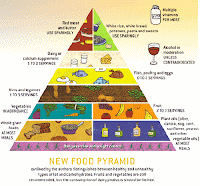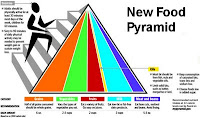The USDA branch of government has been dumbing down their advice to us for nearly a century. They mean well. As America urbanized after the Great War, while public health in general improved, chronic diseases began showing up more frequently, and peoples' average weight trended upward, prompting some in government to "do something about it."
They began issuing "food guide" advice in 1916, and settled on "four food groups" in 1956: meat, dairy, grains, and fruits & veggies. Various versions of the list were fashioned until 1992, when they went graphic and the first Food Guide Pyramid was issued:
 There are six categories in this pyramid: grains at the base, fruits and vegetables in separate boxes at the next level, then dairy and meats above, and finally dietary fats, to be used "sparingly", as though meats contained no fat.
There are six categories in this pyramid: grains at the base, fruits and vegetables in separate boxes at the next level, then dairy and meats above, and finally dietary fats, to be used "sparingly", as though meats contained no fat.This worked during the years that people worked, by which I mean a predominance of physical labor. But bread, the "staff of life", has been found to be the foundation of fat for the sedentary. With the spread of the "service economy" and the "information economy" has come the spreading of our bottoms.
 I don't know what year this version came out, but it was in the mid 1990s. In a way it is more complex, but it is an attempt to refocus our attention away from the "bad carbs" (potatoes and bread) to "good carbs" (beans, lentils and other legumes) and to emphasize even more greens and fruits. Note also the fillip to multivitamins and a glass of red wine for the heart.
I don't know what year this version came out, but it was in the mid 1990s. In a way it is more complex, but it is an attempt to refocus our attention away from the "bad carbs" (potatoes and bread) to "good carbs" (beans, lentils and other legumes) and to emphasize even more greens and fruits. Note also the fillip to multivitamins and a glass of red wine for the heart.Why the addition of a multivitamin? In older literature we read of people having "an ordinary four-pound meal", then working until sundown at hard labor. If you are burning 4,000 calories as you work, you can afford to eat a lot. For less strenuous occupations, the standard became 2,000 calories for "wholly sedentary workers" and 2,400 for those that do at least a little physical labor, or at least work out a couple times a week. It's a simple equivalence: half the total food equals half the natural vitamin sources, so it is more likely you'll need a multivitamin. And what happened? We still got fat.
 As I recall, this version arrived in about 2000, or a year or two later. Now the proportions are shown by the widths of the triangles, and the importance of exercise was introduced.
As I recall, this version arrived in about 2000, or a year or two later. Now the proportions are shown by the widths of the triangles, and the importance of exercise was introduced.In my experience, observing others' and my own behavior, this became the most-ignored promotion ever. It exemplifies the adage, "If you make it truly idiot-proof, only an idiot is willing to use it." True idiots couldn't figure it out, and the rest of us were too insulted to care what the USDA thinks.
 So this morning, all the pyramids were discarded in favor of a pie chart. Meat is not mentioned, I suppose to avoid offending vegetarians. "Protein" is in its place (Never mind that every food group contains some protein). The biggest section is Vegetables. Dairy gets its own mini-circle.
So this morning, all the pyramids were discarded in favor of a pie chart. Meat is not mentioned, I suppose to avoid offending vegetarians. "Protein" is in its place (Never mind that every food group contains some protein). The biggest section is Vegetables. Dairy gets its own mini-circle.It's too bad they didn't keep some indication of exercise, because that is the key to health. It is hard to keep physical work and labor and exercise as a part of daily life in a sedentary occupation. In the absence of the downright exhausting level of labor most people used to undergo, sure we are going to get fatter.
Human nature ensures two things: most people eat a lot because eating is enjoyable for most of us; and most people avoid exertion because it is so much easier to do more enjoyable things. A few people actually enjoy working out. A few people actually become satisfied with a small amount of food. There are genetic differences among us because of all kinds of differences in the way our ancestors lived, and natural selection fitted various populations to the prevailing lifestyle. For the majority of us, with less strenuous lifestyles overall, our "human nature" leads to overweight or obesity, and our taste in foods often unbalances our diet.
The basic question to answer, then, is "Why make myself uncomfortable when I can afford to be comfortable?" In the West, at least, most people can afford a surfeit of food, and most can afford to make a living without breaking a sweat. We eat more because we can, and we exercise less or not at all because we don't need it to make a living. No plate or pyramid or other top-down advice is going to change that. We do what we want. When we want better health, badly enough, we'll find a way to get better health, even if by then "optimum health" has gone quite out of reach. It is the way we are.



No comments:
Post a Comment